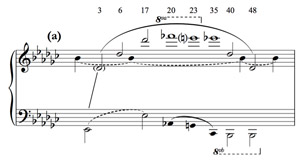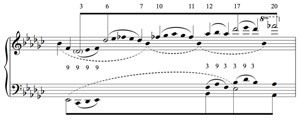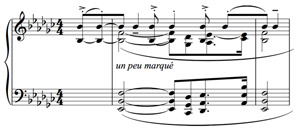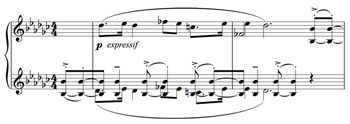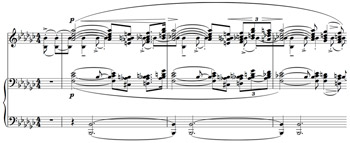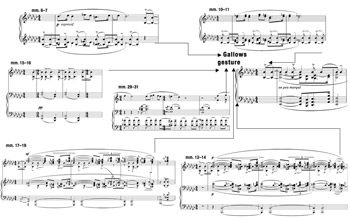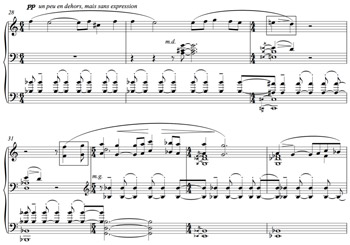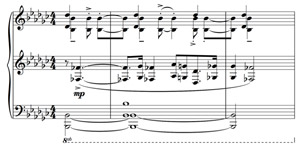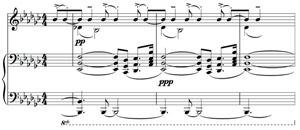Eternity in Each Moment: Temporal Strategies in Ravel’s “Le Gibet” *
Jessie Fillerup
KEYWORDS: temporality, moment form, piano music, linearity, nonlinearity, continuity, discontinuity, Ravel, Henri Bergson, Aloysius Bertrand
ABSTRACT: This paper suggests that Ravel’s “Le Gibet” from Gaspard de la nuit (1909) features temporal and formal innovations that anticipate those found in Debussy’s Jeux (1913) and Stravinsky’s Symphonies of Wind Instruments (1920). The analysis combines voice-leading techniques with Stockhausen’s notion of “moment form” (further developed by Jonathan Kramer), revealing multiply directed temporal strategies that assert points of stasis, nonlinearity, continuity, and discontinuity. In the poem by Aloysius Bertrand that inspired Ravel’s music, the poetic devices typical of French Romanticism contrast with Ravel’s distinctly modern approach to musical temporality, which explores both durational and spatial models of time.
Copyright © 2013 Society for Music Theory
You must live in the present, launch yourself on every wave, find your eternity in each moment. Fools stand on their island opportunities and look toward another land. There is no other land; there is no other life but this, or the like of this.
~ Henry David Thoreau
[1.1] In 1958, Pierre Boulez suggested that the experience of listening to music was “no longer directional, but time bubbles,” as music unfolds for the listener without purposeful motion from beginning to end (1986, 178). Composers and scholars have identified a handful of musical works from the early twentieth century that both invite this approach to musical listening and function as prescient examples of structural trends to come. In particular, Debussy’s Jeux (1913) and Stravinsky’s Symphonies of Wind Instruments (1920) have been singled out for special attention. Symphonies has inspired formal and temporal analyses from Edward Cone, Jonathan Kramer, and Christopher Hasty, among others, and it was described by Alexander Rehding as a “paradigm of discontinuity.”(1) The Darmstadt composers, including Pierre Boulez and Karlheinz Stockhausen, championed Jeux decades after the ballet had been overshadowed by the premiere of Stravinsky’s The Rite of Spring. Boulez paid particular attention to Jeux’s shifting juxtaposed gestures, which were underpinned by structural homogeneity. Each of these techniques encouraged a “time bubble” approach to music listening that recognized both pulsed time and a temporal order freed from succession—or, as Gilles Deleuze put it, space-times that are either “striated” (pulsed) or “smooth” (indeterminate)(2). The panegyrics devoted to Jeux, The Rite of Spring, Symphonies of Wind Instruments, and a handful of other early twentieth-century works celebrate the way these works attend to both types of temporality and invite alternative modes of listening.
[1.2] Rarely has similar praise been directed toward Maurice Ravel’s music, which remains peripheral in musicological discourse despite recent developments in scholarship.(3) Ravel is typically viewed as a classicist in disguise: he may have worked in the twentieth century, but he was disinclined to experiment with the same freewheeling abandon that Debussy did.(4) Ravel’s musical forms are often interpreted in light of their eighteenth-century antecedents; those that deviate from classical norms, like Boléro, are easily dismissed with help from the composer himself, who described this work as “an experiment in a very special and limited direction” that resulted in “orchestral tissue without music” (Calvocoressi 2003, 477). But twenty years before the ballet premiere of Boléro, Ravel wrote another piece that may be considered a formal experiment: “Le Gibet,” the middle work of the piano triptych Gaspard de la nuit. The structural dimensions of the piece, while evoking classical prototypes, also anticipate the attention paid by Stravinsky, Debussy, and several mid-twentieth century composers to heterogeneous temporal relationships, especially the mediation of circularity, linearity, and discontinuity.
[1.3] Jann Pasler’s study of form in Debussy’s Jeux provides a useful analytical companion to “Le Gibet.” For Pasler, abrupt changes in meter and tempo in Jeux suggest discontinuity, while motivic similarity and constancy of pulse help to bind discontinuous gestures (Pasler 2008, 91–95). Her analysis relies in part on philosophical scaffolding supplied by Henri Bergson, whose theory of duration has much to recommend to music studies. In “The Perception of Change” (2002; La Perception du changement, 1911), Bergson explains the concept of temporal indivisibility with a spatial analogy: Zeno’s paradox of Achilles racing a tortoise who was given a head start. Though most would wager that Achilles would win the race despite his initial disadvantage, Zeno offers a mathematical (or metaphysical) paradox that makes the tortoise the winner. Once Achilles begins the race, he starts making up the distance he lags—but as he does so, the tortoise is traveling a little further ahead, which leaves Achilles another interval to make up. Though the tortoise loses his lead by increments, Achilles can never overcome his opponent, making the tortoise the eventual winner in the race. Bergson defuses Zeno’s paradox with a simple question: if common sense dictates that the tortoise should lose, why not ask Achilles how he won the race? Achilles responds that he did not run according to Zeno’s description, by moving from a point in space to the point that the tortoise had last occupied. Instead, he took one step after another until he finally passed the tortoise, claiming, “I thus accomplish[ed] a series of indivisible acts” (Bergson 2002, 257). The notion of continuity is a key element of Bergson’s theory of time—or duration (durée), as he preferred to call it.(5)
[1.4] Bergson finds a similar error in our understanding of time that may be illuminated by considering the hands of a clock face. The movement of the hands corresponds to the oscillations of a clock pendulum, and there is but one position of the hand (or the pendulum) in space; past oscillations no longer exist. We preserve the memory of these past oscillations and order them, creating succession out of the single movement of the pendulum juxtaposed spatially with itself. We create the illusion that time is homogeneous, divisible into discrete moments that are represented by (and sometimes equivalent to) the oscillating pendulum or the moving hands. Bergson counters the perceived homogeneity of time with the concept of duration, which he claims more accurately reflects our temporal experience: memory and perception are part of a continuous, interpenetrating process in which the activities of the past and the present cannot be easily distinguished (1960, 107–10). Contemporaries of Bergson, like psychologist William James, identified different types of temporal proximity—primary and secondary memories, for example, or the “specious present,” which may be temporally extended for several seconds.(6) In Bergson’s theory, by contrast, “nothing is ‘far away.’ ” (Kern 2003, 44). The present is a matter of attentional focus, which allows memories and experiences from the past to occupy, and not merely influence, the present.
[1.5] Often Bergson used musical analogies to explain the fluid, extended nature of duration. Melody becomes a sort of idée fixe, recurring in several iterations of Bergsonian theory, usually to impress upon readers the concepts of immediacy and continuity. By viewing music as an art of suggestion rather than expression, Bergson aligned himself with the Symbolists, though his favorite composer was reportedly César Franck.(7) In a 1911 lecture, he developed one of his musical analogies with characteristic detail:
We have, no doubt, a tendency to divide [a melody] and to picture, instead of the uninterrupted continuity of melody, a juxtaposition of distinct notes. But why? Because we are thinking of the discontinuous series of efforts we should be making to recompose approximately the sound heard if we were doing the singing, and also because our auditory perception has acquired the habit of absorbing visual images. We therefore listen to the melody through the vision which an orchestra-leader would have of it as he watched its score. We picture notes placed next to one another upon an imaginary piece of paper. We think of a keyboard upon which someone is playing, of the bow going up and down, of the musicians, each one playing his part along with the others. If we do not dwell on these spatial images, pure change remains, sufficient unto itself, in no way divided, in no way attached to the ‘thing’ which changes. (2002, 259)
Images, whether projections or memories, interfere with the unity and continuity suggested by melody: while pitches and rhythms change, there nevertheless remains “succession without distinction” (Bergson 1960, 101).
[1.6] The musical dimension of Bergson’s temporality makes its application to music analysis even more compelling, particularly in a contemporaneous work like “Le Gibet,” whose architecture may be newly interpreted using Bergsonian thinking. A voice-leading analysis of “Le Gibet” reveals multiply directed temporal strategies that assert points of stasis, nonlinearity, continuity, and discontinuity. The analysis yields points of convergence with the poetic text that inspired the work, as well as certain musical structures of Debussy’s. But ultimately it suggests that music and text fulfill different aims, and that the structural similarities between Debussy’s music and “Le Gibet” are used to destabilize the listener’s grasp of the familiar. A more useful connection may be forged between Ravel’s approach to temporality and Stockhausen’s notion of moment form, as developed by Jonathan Kramer.
Challenges to Temporal Continuity
[2.1] When Gaspard premiered in January 1909, critics described “Le Gibet” as “doleful” and “monotonous,” evoking an air of “acerbic disquiet” (Chantavoine 1909, 261; Laloy 1909, 396). Aloysius Bertrand’s prose poems had inspired the suite, and the three poems that shared titles with Ravel’s music were printed in the program (Marnold 1909, 548). In Bertrand’s poem “Le Gibet,” the narrator tries to identify a sound by posing a series of queries: “Is it the night wind shrieking, or the hanged man sighing on the gibbet?” The final stanza reveals the source of the sound: “It is the bell that tolls from the walls of a city beyond the horizon, the corpse of a hanged man reddened by the setting sun” (Bertrand 1972, 167). Ravel’s “Le Gibet” begins with this tolling bell, a fixed-register
[2.2] The piece may be configured in two or three parts: Peter Kaminsky prefers the former, Roy Howat the latter. In Howat’s reading, the opening section and the recapitulatory close flank a brief central section, measures 28–34 (2000, 82–84). The structural role assigned to this seven-bar passage (in a piece of fifty-two measures) perhaps exaggerates its proportional significance, but Howat is right to distinguish the passage from what came before, both for its reduced texture and for the performance indication to play it sans expression. (This contrasts with the expressif marking assigned to two phrases in the opening section.) Kaminsky similarly demarcates measure 28 as a structural midpoint that introduces a new theme, and with it, stuttering moves toward tonal clarity (2011, 101, 106–07). Common to both analyses is the notion of circularity (revealed through arch form for Howat). Like Kaminsky, I prefer a two-part formal model for “Le Gibet” that captures its recapitulatory symmetry while avoiding the problem of the proportionally meager center section. But the analysis that follows is likewise congruent with Howat’s three-part structure, in which tonal harmonic progressions are repeatedly attempted and foiled despite the unfolding “motions of classical sequence” (2000, 84).
Example 1a. Background graph of “Le Gibet.”
(click to enlarge)
Example 1b. Middleground graph of “Le Gibet,” measures 1–20
(click to enlarge)
[2.3] Example 1 reveals the work’s symmetrical architecture, including motivic parallelisms and arch gestures on multiple structural levels. Though the
[2.4] When examining “Le Gibet” from a Bergsonian perspective, a diachronic reading is critical to understanding the dynamic relationship between memory, perception, and linearity (or lack thereof). In the first section of the piece, Ravel establishes phrasing patterns that realize in sound Bergson’s understanding of the relationship between perception and memory:
Perception, however instantaneous, consists then in an incalculable multitude of remembered elements; and in truth every perception is already a memory. Practically we perceive only the past, the pure present being the invisible progress of the past gnawing into the future. (1950, 194)
The opening phrasing patterns of “Le Gibet” become “remembered elements” whose repetition and primacy leave a powerful imprint upon the listener. In the phrases that follow, linear and non-linear structures generate uncertain projections about future moments. These projections form when memory simultaneously interacts with perception to shape the past, apprehend the present, and project the future.
Example 2. “Gallows” gesture, measures 3–4
(click to enlarge)
Audio Example 1
Example 3. Arch-shaped opening melody, measures 6–7
(click to enlarge)
Audio Example 2
Audio Example 3
[2.5] The piece opens in a Phrygian-tinged
[2.6] The return of the gallows between melodic statements blunts the listener’s projections of linear development in two ways. First, both the potential circularity of the opening phrase pattern and the arch shape of the
Audio Example 4
Example 4. Melodic variant, measures 12–14
(click to enlarge)
Audio Example 5
[2.7] This possibility emerges right away. Near the end of measure 11 the
[2.8] James Hepokoski introduced a taxonomy of introductory formulas in Debussy’s music in which he classified dozens of pieces by type—mostly repertoire that Ravel knew intimately, and some of which he greatly admired (1984, 44–59). Hepokoski identified three types of openings: monophonic, modal/chordal, and introductory sequences/expansions; the last of these combines with either the first or the second type. Modal/chordal openings typically begin with four chords of the same rhythmic value, with one of the chords sounding twice (three sonorities, four sounds). The chords, which tend to revolve around an axis, produce an effect of “swaying, static circularity” that is further reinforced by their repetition before new material enters. Examples of this type of opening include Saint-Saëns’s Le Pas d’armes du Roi Jean and Debussy’s La Damoiselle élue, both of which conjure funereal imagery (Hepokoski 1984, 48). When the modal/chordal opening combines with the third type of formula—sequences and expansions—the modal/chordal phrase leads to a pause, followed by an elaboration of the first phrase that emerges from the preceding silence. This phrase leads to another pause, or it is succeeded either by contrasting ideas or a further elaboration of the opening phrase.
[2.9] “Le Gibet” evokes the third type of formula while stubbornly defying key aspects of it. The opening phrase does not emerge from silence, which is typically the case in Debussy’s music: rather, the
Example 5. Select phrases re-directed to the gallows gesture
(click to enlarge)
Audio Example 6
Audio Example 7
Audio Example 8
[2.10] By measure 14, phrasing patterns have proven inconsistent. At least four structural possibilities for the phrase that follows emerge here: first, the phrase may repeat the melodic variant just heard; second, it may develop the variant; third, it may re-route itself to the gallows; or fourth, it may introduce a new musical idea. The melodic contour of the variant does not imply any particular direction, though the descending scalar motion of its final three notes (
[2.11] Bergsonian continuity suggests a dynamic relationship between memory and perception: as perception is shaped by memory, it becomes memory and shapes perception in a fluid, indivisible exchange. A listener of “Le Gibet” remembers the circular gallows gesture at the same time that she perceives an unrelated melodic statement, which may incline her to relate these musical incidents despite their discrete musical qualities. But she soon discovers that the gallows sometimes interrupts linear melodic gestures or appears independently from melodies altogether. The gallows shifts in her perception, variously occupying foreground and background positions—or perhaps, like the famous duck-or-rabbit figure, constantly fluctuating between them, unable to find stable ground.(8)
[2.12] Continuity starts to break down within the first few phrases, resulting in the perceptual process described by Bergson as “homogenous time,” in which temporal perception is mapped onto space (1960, 121). This occurs when listeners faced with these shifting phrase patterns juxtapose potential musical events, just as I did when describing the four compositional choices that could have followed measure 14. These projections create virtual simultaneities of sound that may be apprehended spatially and compared at once, like the oscillations of a clock pendulum. None of them is yet realized, but they are nevertheless phenomenological realities: products of our imagination, with a spatial orientation that disrupts Bergsonian continuity.
Continuity Restored, Revoked
Audio Example 9
[3.1] To conclude the first half, Ravel strings together inversions of an
Audio Example 10
Example 6. Linear phrases with connective material in boxes, measures 28–34
(click to enlarge)
Audio Example 11
[3.2] The impassive melody that opens the second half of the piece does not seem promising in this respect, for it begins and ends with a sigh motive (F–E, measures 28–29) that exhibits the same potential for circularity as the arch-shaped
Example 7. Recapitulated melody, measures 41–43
(click to enlarge)
Example 8. Recapitulated gallows gesture, measures 48–50
(click to enlarge)
Audio Example 12
[3.3] By measure 35, the melodic variant first heard in measures 12–14 returns over a
Linear Text, Nonlinear Music
[4.1] The hypnotic effect of “Le Gibet” belies the structural instabilities that roil beneath its placid, symmetrical surface. The piece travels through a variety of phrase types and expands registrally to encompass nearly the full range of the piano, but its foreground and background circularities suggest that, ultimately, no movement or expansion occurs. Jonathan Kramer’s description of linear and nonlinear hearings provides a helpful framework for understanding the temporal processes that unfold in “Le Gibet.” Kramer associates nonlinearity with cumulative listening, verticality, stasis, persistence, consistency, and atemporality, and linear music with motion, change, progression, temporality, and the horizontal (1988, 63). For Kramer the presence of nonlinearity does not imply discontinuity, nor does it eliminate the possibility for linear progressions or motivic organization. A nonlinear work
does not exhibit large-scale closure. It does not begin but merely starts. It does not build to a climax, does not purposefully set up internal expectations,. . . does not build or release tension, and does not end but simply ceases. (Kramer 1988, 55)
If linear music establishes patterns in the listener’s memory that imprint (and are imprinted by) perception, then nonlinear music features subtly changing contexts in which the listener no longer expects variety, growth, or progression. To clarify Kramer’s analysis, the notion of atemporality in nonlinear music (a musical implausibility) may be replaced with Bergson’s “spatialized” simultaneities, which disrupt the sequential, temporal continuity of linear hearings.
[4.2] Nonlinearity manifests inconsistently in “Le Gibet.” The persistent
[4.3] But linear passages do appear, as when Ravel chooses to connect the opening melody with a melodic variant (in measures 10–14) instead of interpolating the gallows gesture. Passages that conclude the first half of the piece (in measures 20–27) and begin the second half (measures 28–34) feature linear transitions and motivic relationships which strengthen continuity and direction. Marked contrasts in texture and thematic material suggest that these passages belong to different structural halves, but grouping them together through linearity creates a structural midpoint that breaks away from the two-part model. If Ravel achieves some measure of predictability through architectural symmetry, he undermines it as we listen moment to moment, our projections often marked by persuasive uncertainty.
[4.4] Bertrand’s poem, “Le Gibet,” seems to generate similar uncertainty in the reader.(11) (The complete text and translation is reproduced in Figure 1.) Five of the six phrases begin with anaphoric questioning (serait-ce
Figure 1. Aloysius Bertrand, Gaspard de la nuit, “Le Gibet”
Ah! ce que j’entends, serait-ce la bise nocturne qui glapit, ou le pendu qui pousse un soupir sur la fourche patibulaire? Serait-ce quelque grillon qui chante tapi dans la mousse et le lierre stérile dont par pitié se chausse le bois? Serait-ce quelque mouche en chasse sonnant du cor autour de ces oreilles sourdes à la fanfare des hallali? Serait-ce quelque escarbot qui cueille en son vol inégal un cheveu sanglant à son crane chauve? Ou bien serait-ce quelque araignée qui brode une demi-aune de mousseline pour cravate à ce col étranglé? C’est la cloche qui tinte aux murs d’une ville sous l’horizon, et le carcasse d’un pendu que rougit le soleil couchant.Ah! What do I hear? Is it the night wind shrieking, or the hanged man sighing on the gibbet? Might it be a cricket singing hidden in the moss and the sterile ivy, with which the wood shields itself out of pity? Might it be a fly hunting and sounding its horn around those ears, deaf to the fatal fanfare? Might it be a scarab beetle plucking in its unstable flight a bloody hair from its bald skull? Or might it be a spider, weaving a length of muslin as a scarf for that strangled neck? It is the bell that tolls from the walls of a city beyond the horizon, the corpse of a hanged man reddened by the setting sun.(12)
[4.5] But the poem’s epigraph—“What do I see stirring on that gibbet?”—prompts the reader to look, in defiance of the narrator’s appeals to hearing in the stanzas that follow. Like most of the poems in Gaspard, “Le Gibet” displays pictorial and spatial qualities consistent with French literary aesthetics of the nineteenth century, as French writers sought to appropriate effects that had long been associated with painting and music. Théodore de Banville’s view of poetry as a type of Gesamtkunstwerk was typical, building on the aesthetic theories of Victor Cousin and Théodore Jouffroy (Scott 1994, 71):
[La Poésie] est à la fois Musique, Statuaire, Peinture, Eloquence; elle doit charmer l’oreille, enchanter l’esprit, représenter les sons, imiter les couleurs, render les objects visibles, et exciter en nous les mouvements qu’il lui plait d’y produire; aussi est-elle le seul art complet, nécessaire, et qui contienne tous les autres.[Poetry] is at once Music, Sculpture, Painting, and Oratory; it should charm the ear, enchant the mind, represent the senses, imitate colors, make objects visible, and arouse in us the movements that it seeks to produce; therefore it is the only complete and necessary art, which contains in itself all the others. (Banville 1881, 8)
Writers often achieved this aim by juxtaposing adjectives as if they were adjacent pigments on a canvas, the literary syntax “reproducing not a logical order of relationships but the order of sensations” (Scott 1994, 71).
[4.6] Peter Kaminsky finds this sensory substitution a repressive act: the narrator knows what he sees but only acknowledges it in the poem’s final stanza, when he finally substitutes “c’est” for “serait-ce” (2011, 98–99). For Kaminsky, the harmonic ambiguity of Ravel’s music also leads to resolution, reflecting the narrator’s psychological passage from repression to acceptance. The music similarly parallels the “formal circularity” of the poem, a design which suggests that the cycle of repression and acknowledgement could reverse itself. There is even greater formal mobility within the poem than Kaminsky asserts, since each of the first five stanzas could be re-ordered without significantly disrupting poetic teleology. The sounds and images evoked—the hanged man, the cricket, the fly, the beetle, the spider—may be experienced in the same way that a roving eye might take in the visual details of a painting, without adhering to a particular order of events. Charles Baudelaire’s preface to Petits poèmes en prose (a work inspired by the prose poetry of Gaspard) similarly grants the reader permission to rearrange the poems in the collection at will. This “discontinuous mode of reading” calls into question not only boundaries between genres (poetry versus prose), but also between the acts of composing and reading (Sieburth 1985, 243).
[4.7] Bertrand’s “Le Gibet” is freighted with the trappings of romanticism, but like its companion poems in Gaspard, its macabre sensibility may be more parody than cliché. The collected poems are related by theme or affect but little narrative: each poem is a vignette, introducing images, characters, and stories that require no prelude or continuation. Two prefaces and an opening and closing dedicatory poem encase Gaspard’s six books of poetry. This framing through architectural paratexts complements the structure of the individual poems themselves, with each introduced by an epigraph (or two) that may be an object of parody.(13) Confusion of purpose, structure, and affect typifies Gaspard, which subverts conventional forms by exploiting them excessively. Its ambiguities correspond to the prose poem itself—a hybrid genre in which the combination of poetic and prose elements constitutes a textual paradox. In “Le Gibet,” the sensory and psychological disorientation that confronts the poetic narrator seems to be reflected in the poem’s temporal circularity and fragmentation, as well as its potential to be re-composed by the reader.
[4.8] Yet the pattern of questioning established in the poem’s first stanza does not invite speculation about poetic structure: by the second stanza its rhetorical plan is clear, creating an expectation that the questions posed will ultimately be answered. If the narrator chronicles a cycle of repression and acknowledgement that can begin anew, poetic structure suggests otherwise. A reader may re-organize the presentation of images and sounds, but the final stanza of the poem disrupts the rhythmic anaphora that enables nonlinear readings. In a cyclical interpretation, the last stanza must still perform this function: acknowledgment cannot cycle back to repression. The poem’s conclusive statement—“C’est la cloche”—is a temporal and structural endpoint. Beneath the poem’s internal narrative fluctuations lies an arrow of time that points inexorably toward the discovery (or acknowledgement) of a horrifying truth.
[4.9] The hypnotic and insistent anaphora in Bertrand’s poem may function ritualistically for the reader, like an incantation or a chant. For Hepokoski, the “curious, static openings” in Debussy’s music also serve a ritualistic purpose, inviting the listener to emerge from the “sadly banal and unclean world” into a sacralized aesthetic space (1984, 54). Ravel’s use of repetition in “Le Gibet”—particularly at the opening of the piece, when he interpolates the gallows at unpredictable moments—prepares a threshold of a different sort. If the creatio ex nihilo structure of Debussy’s sacralized musical introductions eases the ritualistic passage to the “purer world of enchantment and art,” (1984, 54) then “Le Gibet” offers its structural opposite: a musical creation through which we enter the oblivion of death. In adapting Hepokoski’s third type of formulaic opening, which acts like “meditative respiration: multiple breaths,” (1984, 54) Ravel seems to parody its characteristic efflorescence, as death replaces breath. Perhaps this is why the tolling bell displaces silence as a conventional background: absent the rhythms and silences of respiration, it can merely memorialize what once was.(14)
[4.10] Jean Marnold, the dedicatee of “Le Gibet,” commented that Ravel’s decision to accompany the premiere of Gaspard with copies of the corresponding Bertrand poems revealed the composer’s desire to represent programmatically the “pseudo-medieval verbal illumination” that was his literary model. Ravel’s impulse to pay homage to a fantastic brand of romanticism produced, for Marnold, a work of “the most audacious modernity” (1909, 549). The eerie phantasmagoria of Ravel’s music conjures Gothic and romantic images of Edgar Allan Poe’s work, specifically the mute horror tinged with parody found in tales like “The Premature Burial.” But the multi-dimensional temporality of “Le Gibet” is indeed audaciously modern, displaying a type of spatialized duration that would come to be valued by composers who sought alternatives to sequential continuity—the musical arrow of time.
Moment Form and Spatial Time
[5.1] In Bergsonian thought, the notion of temporal proximity is a non-starter. Even the claim that all memories are temporally equidistant according to Bergson’s theory would displease the philosopher because of its appeal to spatial dimensions. But this metaphorical temporal model nevertheless helps to illustrate the continuity of memory. If applied to musical listening, phrases acquire a potential immediacy and mobility: any past phrase, no matter how distantly past, may occupy the present if the listener directs his attentional focus toward it, just as any phrase unfolding in the present may recede in importance as the listener contemplates past or future phrases. This temporal fluidity emerges clearly in “Le Gibet”—a piece in which little else is clear, as the interaction of circular, linear, and nonlinear structures undermine the listener’s ability to generate expectations. Of all the static, self-contained phrases in the piece, the gallows gesture most typically evokes the Bergsonian phenomenon of continuous presence. Mere repetition ensures that it attracts the listener’s attention, while its potential recurrence relates past musical experiences to projected ones.
[5.2] “Le Gibet” exhibits characteristics of moment form, which was described by Stockhausen in 1960 and later elaborated by Jonathan Kramer. Moments, for Kramer, consist of static ideas or discrete processes that still pertain to the contextual whole. Because they lack linear progression, moments can often be re-ordered within a work, though many works in moment form do not display structural mobility. Kramer notes the open-ended quality of these forms:
[They] give the impression of starting in the midst of previously unheard music,. . . [and] break off without reaching any structural cadence, as if the music goes on, inaudibly, in some other space or time after the close of the performance. (Kramer 1978, 180)
Moment form may be seen in “Le Gibet” through both the static
[5.3] Bergson claims that “our consciousness, which begins by being only a memory, prolongs a plurality of moments into each other, contracting them into a single intuition” (1950, 292). If the Bergsonian model of listening involves a reciprocal relationship between memory and perception, then it implies the presence of a musical continuity that sustains this dynamic relationship. When Pasler discusses continuity and discontinuity in Debussy’s Jeux, she draws on Bergson’s comparison between temporality and melody: the consciousness “forms both the past and the present states into an organic whole, as happens when we recall the notes of a tune, melting, so to speak, into one another” (Bergson 1960, 100). Pasler argues that the sectional discontinuity of Jeux may be ameliorated by subtle consistencies—rhythms, motives, or harmonies—across sections, allowing the past to permeate the present (Pasler 2008, 95–96).
[5.4] A similar process is at work in “Le Gibet.” Listeners faced with the juxtaposition of linear and nonlinear structures may find Bergsonian continuity fractured. Phrase structure often undermines the reciprocal relationship between memory and perception, encouraging a synchronous mode of hearing in which Bergson’s “plurality of moments”—those remembered, perceived, and projected—are situated side by side, experienced as simultaneity instead of succession. The ostinato that opens and closes “Le Gibet” suggests a static form that, like each moment, is sustained by its own circularity. But the continuity of the ostinato also generates the connective tissue necessary to string together discontinuous gestures. Temporal continuity thus persists, but it is chiefly to enable discontinuity, and with it the spatialized juxtaposition of actual and potential musical events. Perhaps “Le Gibet” maintains its suspenseful effect despite a plodding tempo and flattened dynamic range because it engages the speculative faculties of listeners more frequently and meaningfully than works that are chiefly linear.
[5.5] In an analysis of discontinuity in Debussy’s late works, Marianne Wheeldon describes “Ondine,” from the composer’s second book of preludes, in terms that could also sketch the temporal structure of “Le Gibet”:
Most of the sections that make up “Ondine”. . . are harmonically static, with bass pedal-points underpinning large sections of the music. Moreover, this harmonic stasis is often compounded by a corresponding thematic or motivic circularity, which ensures that there is also little sense of melodic teleology. (2004, 108)
There are a few key differences between the pieces: “Ondine” notably features a wealth of musical ideas, some of which never recur, while “Le Gibet” relies in part on repetition for its effect. But both share the use of discrete, juxtaposed melodic ideas, static harmonic progressions, and the “potential mobility” reminiscent of moment form (Wheeldon 2004, 109). These techniques are also characteristic of Jeux, a work favored by the Darmstadt composers for its non-hierarchical structure and gestural discontinuity. Debussy surely knew “Le Gibet,” for his first book of piano preludes, written about one year after the premiere of Gaspard,
features motives and rhythms similar to Ravel’s piece, including a
[5.6] Kramer traces the origins of moment form to the works of Stravinsky and Debussy, citing the Symphonies of Wind Instruments as a remarkable example of multiply-directed temporal strategies. Of particular interest to Kramer is the work’s hierarchic relationship between voice-leading continuities and discontinuous moments (1988, 222–23). Though the Darmstadt composers identified Jeux as a musical antecedent to their own experiments, Kramer argues that Stravinsky is a truer progenitor, taking steps in Symphonies that exceeded the formal invention of Debussy’s late works (1978, 189).
[5.7] Boulez’s claim that musical listening has lost its directional impetus in favor of “time bubbles” points up a compositional trend that extends through much of the twentieth century: mapping duration onto space in order to neutralize the musical arrow of time.(15) Deleuze offers Boulez’s “time bubbles” to refer to the notion of “smooth” space-time, in which “one occupies without counting, instead of counting in order to occupy” (1998, 71). Chronometric time is characterized by division, direction, and boundaries, while smooth space-time is unstructured and boundless (Deleuze 1998, 71; Deleuze and Guatarri 2004, xiii, 399, 411, 420, 526). Neither type is homogenous; both may admit irregularities. In applying these temporal models to Boulez’s music, Deleuze’s use of the word “space-time” suggests that temporality can no longer be distinguished from space, as Bergson would have it.
[5.8] Stockhausen’s moment form similarly reflects characteristics of smooth space-time. Musical ideas are independent and non-hierarchical, encouraging listeners to focus on the present moment. In so doing, listeners make “vertical slices” across the “horizontal” experience of time.(16) This graphical rendering of time is not merely a spatial metaphor for duration; rather, it is an attempt to describe timelessness, a virtually unknown—and perhaps unknowable—phenomenon that challenges fundamental expectations of Western musical listening. György Ligeti and George Rochberg have also favored an approach that frees music from duration and succession, subordinating the temporal to the spatial (Hasty 1986, 59–61). Rochberg, drawing on the poetics of Charles Olson, describes the effect of treating musical moments as objects. No longer “articulating actions of time,” much of twentieth-century music asserts “actions of place,” exchanging what is becoming for what is (2005, 122).(17) Ligeti distinguishes various approaches to musical structure by identifying their place on a temporal-spatial continuum, in which Debussy’s art of juxtaposition over succession is closer to the pure stasis of total serialism than Schoenberg’s musical language, which inhabits conventional duration-based forms (1975, 15–17).
[5.9] In the 1988 Darmstadt lecture, Brian Ferneyhough explained how his Mnemosyne evokes a type of detached temporal consciousness that is self-aware, functioning in a “speculative time-space” (21). Close musical listening produces a temporal experience distinct from musical language—a temporality “closely approaching a physical, objectivized existence” (Ferneyhough 1993, 21). In Mnemosyne, a click track helpfully aids synchronization between musical instruments while also representing time measured and perceived as discrete units, as if spatially positioned on a clock face. Ferneyhough embraces a hyper-durational temporality that Stockhausen sought to disrupt by appealing to the extra-temporal concept of eternity through spatial metaphor. But both composers project space onto time in ways that challenge Bergsonian continuity.
[5.10] Modernity—however it is construed—is often considered a question of chronological priority. As an example of discontinuity manifested through moment form, “Le Gibet” precedes both Debussy’s Jeux and Stravinsky’s Symphonies of Wind Instruments.
It is a legitimate entrant in discussions of musical time and structure in the modern era
not just for its chronological position, but for the way it flexes the dynamic tension between linear and nonlinear, continuous and discontinuous ideas. It shows Ravel the classicist comfortably at home with both the heady romanticism of Bertrand’s poetry and the musical implications of modern thinking about time, space, and metaphysics. But perhaps most importantly, “Le Gibet” engages and challenges notions of temporal continuity taken up by later twentieth-century composers. It does not confuse formal and temporal circularity with atemporality, the theoretical eternity posited by Stockhausen and Kramer. Instead it presents a temporal experience that is powerfully multivalent, alternately exercising durational and spatial models. Musical time mapped onto three-dimensional space can seem surprisingly one-dimensional and homogeneous: eternity lacks sensory texture and, strangely, temporal depth.(18) The
Jessie Fillerup
University of Richmond
28 Westhampton Way
University of Richmond, VA 23173
jfilleru@richmond.edu
Works Cited
Banville, Théodore de. 1881. Petit traité de poésie française. Paris: Charpentier.
Bergson, Henri. 2002. “The Perception of Change.” In Henri Bergson: Key Writings, ed. Keith Ansell Pearson and John Mullarkey, 248–66. New York and London: Continuum.
—————. 1960. Time and Free Will: An Essay on the Immediate Data of Consciousness. Trans. F. L. Pogson. New York: Harper.
—————. 1950. Matter and Memory. Trans. Nancy Margaret Paul and W. Scott Palmer. London: George Allen, and New York: Macmillan.
Bertrand, Aloysuis. 1972. Gaspard de la nuit: fantaisies à la manière de Rembrandt et de Callot. Ed. Jean Richer. Paris: Flammarion.
Boulez, Pierre. 1986. “Sound, Word, Synthesis.” In Orientations, ed. Jean‐Jacques Nattiez, trans. Martin Cooper, 177–82. Cambridge: Harvard University Press. Originally published as “Son, verbe, synthèse” in Melos 25, no. 10 (1958): 310–13.
—————. 1968. Notes of an Apprenticeship. Trans. Herbert Weinstock. New York: Knopf.
Bruhn, Siglind. 1997. Images and Ideas in Modern French Piano Music: The Extra‐Musical Subtext in Piano Works by Ravel, Debussy, and Messiaen. New York: Pendragon.
Calvocoressi, Michel‐Dmitri. 2003. “M. Ravel Discusses His Own Work.” In A Ravel Reader: Correspondence, Articles, Interviews, ed. Arbie Orenstein, 476–78. Mineola, NY: Dover. Originally published in The Daily Telegraph, 11 July 1931.
Campbell, Edward. 2010. Boulez, Music, and Philosophy. Cambridge: Cambridge University Press.
Chantavoine, Jean. 1909. Review of Gaspard de la nuit, “Chronique musicale.” La Revue hebdomadaire, March 13: 261.
Cone, Edward T. 1968. “Stravinsky: The Progress of a Method.” In Perspectives on Schoenberg and Stravinsky, ed. Benjamin Boretz and Edward T. Cone, 155–64. New York: Norton.
Corbin, Alain. 1998. Village Bells: Sound and Meaning in the 19th‐Century French Countryside. Trans. Martin Thom. New York: Columbia University Press.
Deleuze, Gilles. 1998. “Boulez, Proust, and Time: ‘Occupying Without Counting.’ ” Trans. Timothy S. Murphy. Angelaki: Journal of the Theoretical Humanities 3: 69–74.
Deleuze, Gilles and Félix Guatarri. 2004. A Thousand Plateaus: Capitalism and Schizophrenia. Trans. Brian Massumi. London and New York.
Ferneyhough, Brian. 1993. “The Tactility of Time.” Perspectives of New Music 31, no. 1: 20–30.
Gilson, Etienne. 1947. “The Glory of Bergson.” Thought 22: 581–84.
Hasty, Christopher. 1986. “On the Problem of Succession and Continuity in Twentieth‐Century Music.” Music Theory Spectrum 8: 58–74.
Hepokoski, James. 1984. “Formulaic Openings in Debussy.” 19th‐Century Music 8, no. 1: 44–59.
Howat, Roy. 2009. The Art of French Piano Music: Debussy, Ravel, Fauré, Chabrier. New Haven: Yale University Press.
—————. 2000. “Ravel and the Piano.” In The Cambridge Companion to Ravel, ed. Deborah Mawer, 71–96. Cambridge: Cambridge University Press.
Huebner, Steven. 2011. “Ravel’s Poetics: Literary Currents, Classical Takes.” In Unmasking Ravel: New Perspectives on the Music, ed. Peter Kaminsky, 9–40. Eastman Studies in Music, ed. Ralph Locke. Rochester: University of Rochester Press.
—————. 2006. “Laughter: In Ravel’s Time.” Cambridge Opera Journal 18, no. 3: 225–46.
http://trace.tennessee.edu/gamut/vol1/iss1/2
Hulse, Brian. 2008. “On Bergson’s Concept of the Virtual.” Gamut 1, No. 1: 1–41.
http://trace.tennessee.edu/gamut/vol1/iss1/2
James, William. 1890. The Principles of Psychology. New York: Henry Holt and Company.
Kaminsky, Peter, ed. 2011. Unmasking Ravel: New Perspectives on the Music. Eastman Studies in Music, ed. Ralph P. Locke. Rochester: University of Rochester Press.
Kern, Stephen. 2003. The Culture of Time and Space: 1880–1918. Cambridge, Mass.: Harvard University Press.
Kramer, Jonathan D. 1988. The Time of Music: New Meanings, New Temporalities, New Listening Strategies. New York: Schirmer.
—————. 1986. “Discontinuity and Proportion in the Music of Stravinsky.” In Confronting Stravinsky: Man, Musician, and Modernist, ed. Jann Pasler, 174–94. Berkeley and Los Angeles: University of California Press.
—————. 1978. “Moment Form in Twentieth Century Music.” The Musical Quarterly 64, no 2: 177–94.
Laloy, Louis. 1909. Review of Gaspard de la nuit, “La Musique—Société Nationale.” La Grande revue 53, (January 25): 396.
Ligeti, György. 1975. “Metamorphoses of Musical Form.” Die Reihe 7 (Form–Space): 5–20. Originally published in 1960.
Marnold, Jean. 1909. Review of Gaspard de la nuit.” Mercure de France 52 (February 1): 548.
Mawer, Deborah, ed. 2010. Ravel Studies. Cambridge: Cambridge University Press.
Narmour, Eugene. 1990. The Analysis and Cognition of Basic Melodic Structures. Chicago: University of Chicago Press.
Nichols, Roger. 2011. Ravel: A Life. New Haven: Yale University Press.
Orenstein, Arbie. 1975. Ravel: Man and Musician. New York: Columbia University Press.
Pasler, Jann. 2008. Writing Through Music: Essays on Music, Culture, and Politics. Oxford: Oxford University Press.
Rehding, Alexander. 1998. “Towards a ‘Logic of Discontinuity’ in Stravinsky’s ‘Symphonies of Wind Instruments’: Hasty, Kramer, and Straus Reconsidered.” Music Analysis 17, no. 1: 39–65.
Richards, Marvin. 1998. Without Rhyme or Reason: Gaspard de la nuit and the Dialectic of the Prose Poem. Lewisburg, PA: Bucknell University Press.
Rochberg, George. 2005. “The Concepts of Musical Time and Space.” In The Aesthetics of Survival, rev. ed., 68–128. Ann Arbor: University of Michigan Press. Originally published in 1963.
Scott, David. 1994. “Writing the Arts: Aesthetics, Art Criticism, and Literary Practice.” In Artistic Relations: Literature and the Visual Arts, ed. Peter Collier and Robert Lethbridge, 61–75. New Haven: Yale University Press.
Sieburth, Richard. 1985. “Gaspard de la Nuit: Prefacing Genre.” Studies in Romanticism 24, no. 2: 243.
Slott, Kathryn. 1981. “Le Texte e(s)t son double. Gaspard de la Nuit: Intertextualité, Parodie, Auto‐Parodie.” French Forum 6, no. 1: 28–35.
Stockhausen, Karlheinz. 1963. “Momentform: Neue Zusammenhänge zwischen Aufführungsdauer, Werkdauer und Moment.” In Texte zur elektronischen und instrumentalen Musik. Vol. 1, 189–210. Cologne: DuMont.
van den Toorn, Pieter. 1983. The Music of Igor Stravinsky. New Haven: Yale University Press.
Wheeldon, Marianne. 2004. “Interpreting Discontinuity in the Late Works of Debussy.” Current Musicology 77, no. 1: 97–115.
Wittgenstein, Ludwig. 2009. Philosophical Investigations. 4th ed. Trans. G.E.M. Anscombe, P.M.S. Hacker, and Joachim Schulte. Oxford: Blackwell.
Footnotes
* My thanks to Peter Kaminsky and Keith Waters, who asked helpful questions about an early draft that I had presented, and to Carlo Caballero, who offered valuable comments on the complete essay. I am also grateful to Benjamin Broening at the University of Richmond for assisting with my recording session and to Evan Wilbur, audio engineer, for his expert recording of my playing.
Return to text
1. Cone 1968, 156–64; Hasty 1986, 58–74; Kramer 1988, 211–13, 221–85; Kramer 1986, 174–78, 181–84; Rehding 1998, 39–65.
Return to text
2. Boulez 1968, 353; Deleuze 1998, 71. Deleuze borrowed the words “striated” and “smooth” from Boulez to describe cultural, political, geographical, and artistic phenomena, including the composer’s music.
Return to text
3. There have been recent edited collections on Ravel’s music by Peter Kaminsky (2011) and Deborah Mawer (2010), while Steven Huebner and Michael Puri have each contributed a number of articles on Ravel in the past five years.
Return to text
4. Descriptions of Ravel as a classicist are too numerous to catalogue here, but classicism is one of the “master tropes” that Kaminsky identifies in Ravel scholarship (2011, 2). It may be traced to publications that emerged in Ravel’s lifetime, and more particularly to those written by Roland‐Manuel, whose perceptions influenced much of the scholarship that followed. Arbie Orenstein’s important Ravel biography (first published in 1975 and since superseded by Roger Nichols in 2011) emphasizes the classical structure of Ravel’s music and notes that the composer appreciated Mozart’s work for its “striking balance between classical symmetry and the element of surprise.” In a recent essay, Steven Huebner turns the question of Ravel’s classicism—for him defined in terms of style, aesthetics, and historiography—away from musical models, instead focusing on literary figures who influenced the composer. See Huebner 2011, 9–12.
Return to text
5. Brian Hulse has used Bergson’s concept of duration to develop a theoretical model for analyzing music, which accommodates the pliable temporal processes of listeners more easily than linear, dichotomous schemes (like Narmour’s “Implication‐Realization” theory, for example). But my interest lies more in forging analogous relationships between Bergson’s thought and Ravel’s music than in creating and applying a systematic theoretical model. See Hulse 2008, 13–18 and Narmour 1990.
Return to text
6. James 1890, 643–52. I am grateful to Laurie Paul at the University of North Carolina at Chapel Hill for suggesting that I look at James’s work.
Return to text
7. Huebner 2006, 230. Bergson’s musical taste rubbed off on one of his students, Etienne Gilson, who also recognized similarities between Bergsonism and musical Symbolism via Debussy. In 1947, Gilson suggested that “César Franck and Claude Debussy poured into our hearts music that was closer to [Bergson’s] profound philosophy than anything words could express” (Gilson 1947, 581–82).
Return to text
8. I am grateful to an anonymous reader of this essay for suggesting that the shifting function of the gallows may relate to perceptions of foreground and background. Regarding the duck‐rabbit figure, see Wittgenstein 2009, 204.
Return to text
9. My numbering of the octatonic collection corresponds to Pieter van den Toorn’s (1983, 49).
Return to text
10. In measures 37–40, Ravel concedes a few slight modifications to the ostinato in order to facilitate voice leading and keyboard fingering. The
Return to text
11. “Le Gibet,” like “Scarbo,” was one of the pièces détachées—poems taken from Bertrand’s portfolio by Victor Pavie, who published Gaspard de la nuit together with the additional poems after Bertrand’s death.
Return to text
12. The translation is mine.
Return to text
13. Ibid., 96. There are seventy‐six such epigraphs heading the poems in Gaspard. Evidence pointing to Bertrand’s use of parody may be seen in the book’s first preface. The first‐person narrator describes a dialogue in which a stranger—whom the narrator assumes to be a “poor, starving artist”—describes his quest for art in rambling passages littered with romantic clichés. The identity of the speakers and the editor, who provides the explanatory footnotes in the text and signs the preface “Louis Bertrand,” is never settled. Marvin Richards (1998, 93–96) and Kathryn Slott (1981, 68–75) interpret the second preface—a commentary on Victor Hugo’s preface to Cromwell—through the lens of parody, too.
Return to text
14. Certainly the bell functioned as a sonic reminder of “the chain binding the living and the dead”—much like another sort of threshold marker, the cemetery, whose function and organization in France started to change in the nineteenth century. Alain Corbin notes that in the nineteenth century French bell makers preferred to work in the cemetery near the church where a bell would be installed—or, barring that option, another area of the village. See Corbin 1998, 83, 287.
Return to text
15. Boulez created time bubbles (bulles de temps) in his sketch for Improvisation III sur Mallarmé. He also embedded them in Éclat to “facilitate non‐pulsed time through indeterminacy.” See Campbell 2010, x, 241.
Return to text
16. “Ein Moment nicht Partikel einer abgemessenen Dauer sein muß, sondern in denen die Konzentration auf das Jetzt—auf jedes Jetzt—gleichsam vertikale Schnitte macht, die eine horizontale Zeitvorstellung quer durchdringen bis in die Zeitlosigkeit, die ich Ewigkeit nenne: eine Ewigkeit, die nicht am Ende der Zeit beginnt, sondern in jedem Moment erreichbar ist.” Stockhausen 1963, 199.
Return to text
17. Rochberg 2005 considers Varèse the first twentieth‐century composer to “realize through music spatial images in sound”—a type of music he calls “space‐form” (108, 116).
Return to text
18. Ligeti 1975 noted this phenomenon in works that foreground temporal variety. Simultaneity of meters, tempos, or events produces a density of effect in which “their original variety is resolved into a high unity” (17).
Return to text
Copyright Statement
Copyright © 2013 by the Society for Music Theory. All rights reserved.
[1] Copyrights for individual items published in Music Theory Online (MTO) are held by their authors. Items appearing in MTO may be saved and stored in electronic or paper form, and may be shared among individuals for purposes of scholarly research or discussion, but may not be republished in any form, electronic or print, without prior, written permission from the author(s), and advance notification of the editors of MTO.
[2] Any redistributed form of items published in MTO must include the following information in a form appropriate to the medium in which the items are to appear:
This item appeared in Music Theory Online in [VOLUME #, ISSUE #] on [DAY/MONTH/YEAR]. It was authored by [FULL NAME, EMAIL ADDRESS], with whose written permission it is reprinted here.
[3] Libraries may archive issues of MTO in electronic or paper form for public access so long as each issue is stored in its entirety, and no access fee is charged. Exceptions to these requirements must be approved in writing by the editors of MTO, who will act in accordance with the decisions of the Society for Music Theory.
This document and all portions thereof are protected by U.S. and international copyright laws. Material contained herein may be copied and/or distributed for research purposes only.
Prepared by Hoyt Andres, Editorial Assistant
Number of visits:
